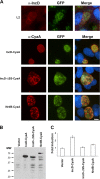Expression and targeting of secreted proteins from Chlamydia trachomatis
- PMID: 24443531
- PMCID: PMC3993338
- DOI: 10.1128/JB.01290-13
Expression and targeting of secreted proteins from Chlamydia trachomatis
Abstract
Chlamydia trachomatis is an obligate intracellular pathogen that replicates in a vacuole termed the inclusion. Many of the interactions of chlamydiae with the host cell are dependent upon bacterial protein synthesis and presumably exposure of these proteins to the cytosol. Because of the dearth of genetic tools for chlamydiae, previous studies examining secreted proteins required the use of heterologous bacterial systems. Recent advances in genetic manipulation of chlamydia now allow for transformation of the bacteria with plasmids. We describe here a shuttle vector system, pBOMB4, that permits expression of recombinant proteins under constitutive or conditional promoter control. We show that the inclusion membrane protein IncD is secreted in a type III-dependent manner from Yersinia pseudotuberculosis and also secreted from C. trachomatis in infected cells where it localizes appropriately to the inclusion membrane. IncD truncated of the first 30 amino acids containing the secretion signal is no longer secreted and is retained by the bacteria. Cytosolic exposure of secreted proteins can be confirmed by using CyaA, GSK, or microinjection assays. A protein predicted to be retained within the bacteria, NrdB is indeed localized to the chlamydia. In addition, we have shown that the chlamydial effector protein, CPAF, which is secreted into the host cell cytosol by a Sec-dependent pathway, also accesses the cytosol when expressed from this system. These assays should prove useful to assess the secretion of other chlamydial proteins that are potentially exposed to the cytosol of the host cell.
Figures








Similar articles
-
Identification and Preliminary Characterization of Novel Type III Secreted Effector Proteins in Chlamydia trachomatis.Infect Immun. 2023 Jul 18;91(7):e0049122. doi: 10.1128/iai.00491-22. Epub 2023 Jun 22. Infect Immun. 2023. PMID: 37347192 Free PMC article.
-
Evidence for the secretion of Chlamydia trachomatis CopN by a type III secretion mechanism.Mol Microbiol. 2000 Dec;38(5):1048-60. doi: 10.1046/j.1365-2958.2000.02212.x. Mol Microbiol. 2000. PMID: 11123678
-
A meta-analysis of affinity purification-mass spectrometry experimental systems used to identify eukaryotic and chlamydial proteins at the Chlamydia trachomatis inclusion membrane.J Proteomics. 2020 Feb 10;212:103595. doi: 10.1016/j.jprot.2019.103595. Epub 2019 Nov 21. J Proteomics. 2020. PMID: 31760040 Free PMC article.
-
Conserved type III secretion system exerts important roles in Chlamydia trachomatis.Int J Clin Exp Pathol. 2014 Aug 15;7(9):5404-14. eCollection 2014. Int J Clin Exp Pathol. 2014. PMID: 25337183 Free PMC article. Review.
-
Got mutants? How advances in chlamydial genetics have furthered the study of effector proteins.Pathog Dis. 2021 Feb 4;79(2):ftaa078. doi: 10.1093/femspd/ftaa078. Pathog Dis. 2021. PMID: 33512479 Free PMC article. Review.
Cited by
-
Emancipating Chlamydia: Advances in the Genetic Manipulation of a Recalcitrant Intracellular Pathogen.Microbiol Mol Biol Rev. 2016 Mar 30;80(2):411-27. doi: 10.1128/MMBR.00071-15. Print 2016 Jun. Microbiol Mol Biol Rev. 2016. PMID: 27030552 Free PMC article. Review.
-
Application of β-lactamase reporter fusions as an indicator of effector protein secretion during infections with the obligate intracellular pathogen Chlamydia trachomatis.PLoS One. 2015 Aug 10;10(8):e0135295. doi: 10.1371/journal.pone.0135295. eCollection 2015. PLoS One. 2015. PMID: 26258949 Free PMC article.
-
Nonspecific toxicities of Streptococcus pyogenes and Staphylococcus aureus dCas9 in Chlamydia trachomatis.Pathog Dis. 2019 Dec 1;77(9):ftaa005. doi: 10.1093/femspd/ftaa005. Pathog Dis. 2019. PMID: 32011704 Free PMC article.
-
Use of aminoglycoside 3' adenyltransferase as a selection marker for Chlamydia trachomatis intron-mutagenesis and in vivo intron stability.BMC Res Notes. 2015 Oct 15;8:570. doi: 10.1186/s13104-015-1542-9. BMC Res Notes. 2015. PMID: 26471806 Free PMC article.
-
Red Fluorescent Chlamydia trachomatis Applied to Live Cell Imaging and Screening for Antibacterial Agents.Front Microbiol. 2018 Dec 18;9:3151. doi: 10.3389/fmicb.2018.03151. eCollection 2018. Front Microbiol. 2018. PMID: 30619216 Free PMC article.
References
-
- Schachter J. 1999. Infection and disease epidemiology, p 139–169 In Stephens RS. (ed), Chlamydia: intracellular biology, pathogenesis, and immunity. ASM Press, Washington, DC
Publication types
MeSH terms
Substances
Associated data
- Actions
- Actions
- Actions
- Actions
- Actions
Grants and funding
LinkOut - more resources
Full Text Sources
Other Literature Sources
Medical

